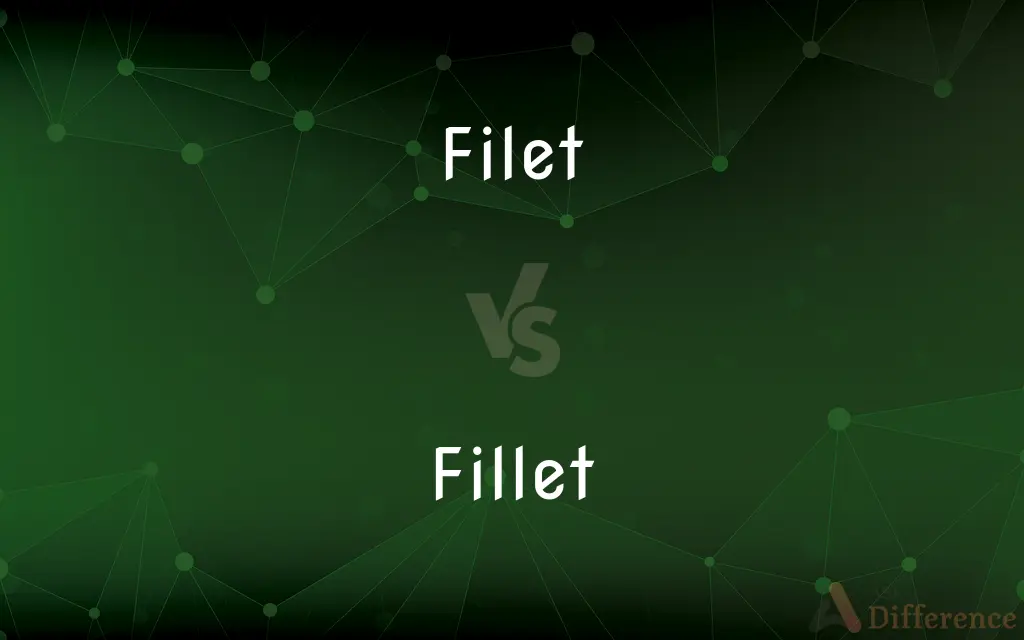Filet vs. Fillet — What's the Difference?
By Tayyaba Rehman — Updated on September 18, 2023
"Filet" is the French term for a boneless cut of meat or fish, while "Fillet" is the English term for the same. Filet evokes French culinary artistry, whereas Fillet is a more generic term in English culinary contexts.

Difference Between Filet and Fillet
Table of Contents
ADVERTISEMENT
Key Differences
Filet and Fillet both refer to a boneless cut of meat or fish. However, "Filet" is primarily the French spelling and is often associated with French cuisine. Fillet, on the other hand, is the common English spelling used in most English-speaking countries.
In certain contexts, Filet might be used to provide a touch of sophistication or elegance to a dish's name on a menu, given its French origins. Fillet, in contrast, is the straightforward term you'd likely see in a grocery store or cookbook in English-speaking regions.
Both Filet and Fillet serve the same culinary purpose: they indicate a piece of meat or fish without bones. However, when used in the U.S., Filet is often reserved for high-quality cuts, especially steak, such as "filet mignon." Fillet covers a broader range of meats and fish.
Filet might be seen as a more specialized term in American English, especially in upscale restaurants. Meanwhile, Fillet is universally understood, regardless of the dining context.
Although Filet and Fillet have the same pronunciation and similar meanings, their different spellings reflect cultural nuances.
ADVERTISEMENT
Comparison Chart
Origin
French
English
Common Usage
Often seen in upscale restaurants, especially for steak
Generic term for boneless cut of meat or fish
Pronunciation
Same as fillet
Same as filet
Culinary Context
Mostly refers to high-quality cuts like filet mignon
Refers to any boneless piece, including fish
Cultural Nuance
Evokes French culinary tradition
A straightforward term in English culinary contexts
Compare with Definitions
Filet
A boneless cut of meat or fish.
She ordered the salmon filet for dinner.
Fillet
A boneless piece of meat or fish.
He grilled a fillet of cod for lunch.
Filet
The French term for a boneless piece.
The chef specializes in filet mignon.
Fillet
A strip of meat devoid of bones.
She prefers the fillet cut as it's easier to eat.
Filet
A refined or delicate cut.
The filet of chicken was tender and juicy.
Fillet
Common term in grocery stores.
Can you pick up a fillet of salmon from the store?
Filet
Used to denote a high-quality cut.
The steak filet was the most expensive item on the menu.
Fillet
A fleshy boneless piece of meat from near the loins or the ribs of an animal
A chicken breast fillet
Roast fillet of lamb
Filet
French spelling of fillet, used especially in the names of French or French-sounding dishes
Filet de boeuf
Fillet
A band or ribbon worn round the head, especially for binding the hair.
Filet
A kind of net or lace with a square mesh.
Fillet
A roughly triangular strip of material which rounds off an interior angle between two surfaces.
Filet
A net or lace with a simple pattern of squares.
Fillet
(in bookbinding) a plain line impressed on the cover of a book.
Filet
Needlework done on a background of this net.
Fillet
Remove the bones from (a fish).
Filet
Variant of fillet.
Fillet
A narrow strip of ribbon or similar material, often worn as a headband.
Filet
A narrow strip of ribbon or similar material, often worn as a headband.
Fillet
A strip or compact piece of boneless meat or fish, especially the beef tenderloin.
Filet
A strip or compact piece of boneless meat or fish, especially the beef tenderloin.
Fillet
A boneless strip of meat rolled and tied, as for roasting.
Filet
A boneless strip of meat rolled and tied, as for roasting.
Fillet
A thin flat molding used as separation between or ornamentation for larger moldings.
Filet
A thin flat molding used as separation between or ornamentation for larger moldings.
Fillet
A ridge between the indentations of a fluted column.
Filet
A ridge between the indentations of a fluted column.
Fillet
A narrow decorative line impressed onto the cover of a book.
Filet
A narrow decorative line impressed onto the cover of a book.
Fillet
(Heraldry) A narrow horizontal band placed in the lower fourth area of the chief.
Filet
(Heraldry) A narrow horizontal band placed in the lower fourth area of the chief.
Fillet
(Anatomy) A loop-shaped band of fibers, such as the lemniscus.
Filet
(Anatomy) A loop-shaped band of fibers, such as the lemniscus.
Fillet
To bind or decorate with or as if with a fillet.
Filet
Variant of fillet.
Fillet
Also fi·let (fĭ-lā, fĭlā′) To slice, bone, or make into fillets.
Filet
To bind or decorate with or as if with a fillet.
Fillet
A headband; a ribbon or other band used to tie the hair up, or keep a headdress in place, or for decoration.
Filet
Also fi·let (fĭ-lā, fĭlā′) To slice, bone, or make into fillets.
Fillet
A thin strip of any material, in various technical uses.
Filet
Alternative form of fillet
Fillet
(construction) A heavy bead of waterproofing compound or sealant material generally installed at the point where vertical and horizontal surfaces meet.
Filet
Alternative form of fillet
Fillet
A rounded relief or cut at an edge, especially an inside edge, added for a finished appearance and to break sharp edges.
Filet
A boneless steak cut from the tenderloin of beef
Fillet
A strip or compact piece of meat or fish from which any bones and skin and feathers have been removed.
Filet
A longitudinal slice or boned side of a fish
Fillet
(UK) A premium cut of meat, especially beef, taken from below the lower back of the animal, considered to be lean and tender; also called tenderloin.
Fillet steak
Filet
Lace having a square mesh
Fillet
(architectural element) A thin featureless moulding/molding used as separation between broader decorative mouldings.
Filet
Decorate with a lace of geometric designs
Fillet
(architecture) The space between two flutings in a shaft.
Filet
Cut into filets;
Filet the fish
Fillet
(heraldry) An ordinary equal in breadth to one quarter of the chief, to the lowest portion of which it corresponds in position.
Filet
A term popularized in upscale dining.
For an exquisite dining experience, try the filet dishes.
Fillet
The thread of a screw.
Fillet
A colored or gilded border.
Fillet
The raised moulding around the muzzle of a gun.
Fillet
(woodworking) Any scantling smaller than a batten.
Fillet
(anatomy) A fascia; a band of fibres; applied especially to certain bands of white matter in the brain.
Fillet
The loins of a horse, beginning at the place where the hinder part of the saddle rests.
Fillet
(transitive) To slice, bone or make into fillets.
Fillet
(transitive) To apply, create, or specify a rounded or filled corner to.
Fillet
A little band, especially one intended to encircle the hair of the head.
A belt her waist, a fillet binds her hair.
Fillet
A piece of lean meat without bone; sometimes, a long strip rolled together and tied.
Fillet
A thin strip or ribbon; esp.: (a) A strip of metal from which coins are punched. (b) A strip of card clothing. (c) A thin projecting band or strip.
Fillet
A concave filling in of a reëntrant angle where two surfaces meet, forming a rounded corner.
Fillet
A narrow flat member; especially, a flat molding separating other moldings; a reglet; also, the space between two flutings in a shaft. See Illust. of Base, and Column.
Fillet
An ordinary equaling in breadth one fourth of the chief, to the lowest portion of which it corresponds in position.
Fillet
The thread of a screw.
Fillet
A border of broad or narrow lines of color or gilt.
Fillet
The raised molding about the muzzle of a gun.
Fillet
Any scantling smaller than a batten.
Fillet
A fascia; a band of fibers; applied esp. to certain bands of white matter in the brain.
Fillet
The loins of a horse, beginning at the place where the hinder part of the saddle rests.
Fillet
To bind, furnish, or adorn with a fillet.
Fillet
A boneless steak cut from the tenderloin of beef
Fillet
A longitudinal slice or boned side of a fish
Fillet
A bundle of sensory nerve fibers going to the thalamus
Fillet
A narrow headband or strip of ribbon worn as a headband
Fillet
Fastener consisting of a narrow strip of welded metal used to join steel members
Fillet
Decorate with a lace of geometric designs
Fillet
Cut into filets;
Filet the fish
Fillet
The English term for a boneless cut.
The recipe requires a chicken fillet.
Fillet
A cut used in various cuisines.
The fillet steak is marinated in herbs and spices.
Common Curiosities
Why might a restaurant use filet instead of fillet on a menu?
A restaurant might use filet to evoke a sense of French culinary elegance.
When should I use filet in a sentence?
Use filet when referencing French cuisine or high-quality cuts, like filet mignon.
Is the pronunciation different for filet and fillet?
No, filet and fillet are typically pronounced the same way.
Is there a major difference between filet and fillet?
Both filet and fillet refer to a boneless cut of meat or fish. "Filet" is the French term, while "Fillet" is English.
Can I use fillet for both fish and meat?
Yes, fillet can be used for both fish and meat.
Is filet used in British English?
British English primarily uses fillet, but filet can appear in the context of French cuisine.
Why is fillet popular in grocery stores?
Fillet is a straightforward term, easily understood to mean a boneless cut.
Is filet mignon a type of fillet?
Yes, filet mignon is a specific type of beef fillet.
Are filet and fillet interchangeable in recipes?
Generally, yes. Both filet and fillet describe boneless cuts of meat or fish.
Can I use filet for fish?
Yes, filet can be used for fish, especially in a French culinary context.
Can I find both terms in a dictionary?
Yes, both filet and fillet will be listed in English dictionaries.
Which is more common in American English?
In American English, both terms are understood, but fillet is more commonly used.
Do both terms have the same culinary history?
Both terms refer to boneless cuts, but filet has a more distinct French culinary history.
Do other languages use similar terms?
Filet is used in French, but many languages have their own terms for boneless cuts of meat.
Which term is older, filet or fillet?
Both terms have ancient origins, but fillet has been used in English longer than the French-inspired filet.
Share Your Discovery

Previous Comparison
Jewelry vs. Jewellery
Next Comparison
Stop vs. PauseAuthor Spotlight
Written by
Tayyaba RehmanTayyaba Rehman is a distinguished writer, currently serving as a primary contributor to askdifference.com. As a researcher in semantics and etymology, Tayyaba's passion for the complexity of languages and their distinctions has found a perfect home on the platform. Tayyaba delves into the intricacies of language, distinguishing between commonly confused words and phrases, thereby providing clarity for readers worldwide.
















































